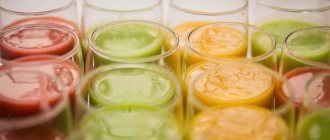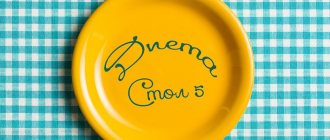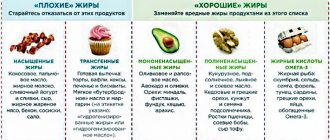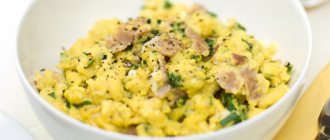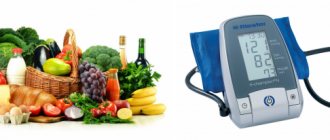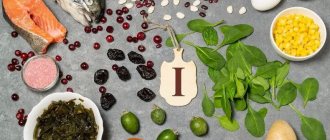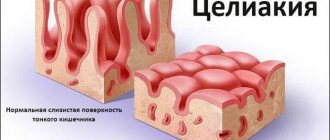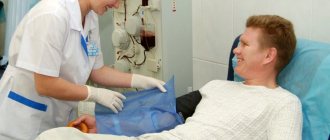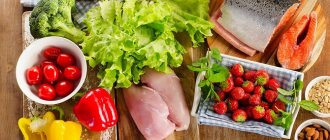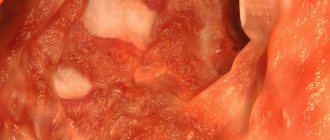Treatment tables (diets) according to Pevzner - this is a diet system created by Professor M.I. Pevzner, one of the founders of dietetics and gastroenterology in the USSR. The system is widely used in the complex treatment of diseases of patients in hospitals and sanatoriums. The tables are also of a recommendatory nature for patients when they are outside medical institutions.
The Pevzner diet system includes 15 treatment tables corresponding to certain groups of diseases. Some of the tables are divided into categories with letter designations. Categories of therapeutic diets correspond to the stage or period of the pathological process: exacerbation (height) of the disease → fading exacerbation → recovery.
Indications for the appointment of treatment tables:
Diet No. 1, 1a, 1b – stomach and duodenal ulcers; Diet No. 2 – atrophic gastritis, colitis; Diet No. 3 – constipation; Diet No. 4, 4a, 4b, 4c – intestinal diseases with diarrhea; Diet No. 5, 5a – diseases of the biliary tract and liver; Diet No. 6 – urolithiasis, gout; Diet No. 7, 7a, 7b, 7c, 7d – chronic and acute nephritis, chronic renal failure; Diet No. 8 – obesity; Diet No. 9 – diabetes mellitus; Diet No. 10 – diseases of the cardiovascular system; Diet No. 11 – tuberculosis; Diet No. 12 – diseases of the nervous system; Diet No. 13 – acute infectious diseases; Diet No. 14 – kidney disease with the passage of phosphate stones; Diet No. 15 – diseases that do not require special diets.
Table No. 0
Recommendations for product types
Indications:
- undergone surgical interventions on the gastrointestinal tract
- rehabilitation of patients in the intensive care unit
- cerebrovascular accident
- after traumatic brain injury
- for patients with infectious diseases who are in serious condition.
Diet: 5–8 times a day
Duration of appointment: as needed
Nutritional features: this diet is designed to restore the patient’s vitality, replenish nutrients and increase the overall resistance of the body. The diet is very strict.
Table No. 1
Recommendations for product types
Indications:
- peptic ulcer of the stomach and duodenum in the acute stage and unstable remission;
- acute gastritis;
- chronic gastritis with normal and high acidity in the stage of mild exacerbation;
- gastroesophageal reflux disease.
Diet: 4–5 times a day
Duration of appointment: at least 2–3 months
Nutrition Features:
Dishes are served in a semi-liquid or jelly-like form, warm; meat dishes and potatoes are cooked without frying. Limit the content of table salt.
Table No. 1a
Modification of the main table with a strict gentle diet that protects the gastric mucosa. This diet involves eating food in liquid, mushy and jelly-like form.
Indications:
- stomach and duodenal ulcers (severe exacerbation);
- exacerbation of chronic gastritis with severe pain;
- condition after gastrointestinal bleeding (after a strict gentle diet).
Diet: 5–6 times a day
Appointment period: several days
Recommended: milk, mucous cereal milk soups with butter; liquid, pureed, milk porridges; soft-boiled eggs or steam omelettes; steam soufflés from lean varieties of fish and meat; unsalted butter or olive oil, cream; berry, fruit (non-acidic) and milk jelly, carrot, fruit juices, rosehip decoction, weak tea with milk.
Salt is limited to 5–8 g, liquid - to 1.5 liters. Additionally, vitamins A, C, and group B are prescribed.
Table No. 1b
Prescribed to ensure a smooth transition from a strict gentle diet to a basic diet.
Indications:
- subacute phase of peptic ulcer and exacerbation of gastritis.
Diet: 4–5 times a day
Appointment period: several days
Nutritional features and products:
The food is prepared in a puree form, 75–100 g of crackers from premium white bread, meat and fish in the form of cutlets, quenelles, and meatballs are added. More often they give pureed milk porridges. Milk and cereal soups.
Indications for use.
Therapeutic diet No. 1 according to Pevzner is recommended for people with peptic ulcers of the stomach and duodenum during the period of recovery after a sharp exacerbation, as well as during exacerbation of these diseases. The same diet is prescribed for exacerbation of chronic gastritis with preserved or increased secretion, as well as during the period of exacerbation after acute gastritis.
Nutritional features.
The main feature of treatment table No. 1 is the moderation of chemical, mechanical and thermal effects on the gastrointestinal tract. The diet limits foods that strongly stimulate the secretion of the stomach, irritate its mucous membrane, and are difficult or take a long time to digest. The main part of food is prepared in pureed, liquid or mushy form; it is boiled in water or steamed. Dishes can be baked, but without a crust. Fish and lean meats can be served in pieces. Too cold and very hot dishes are excluded from the diet. Salt is limited. Also limit foods containing a lot of fiber. It is recommended to take food in small portions, quite often - five to six times a day. By following such a diet, inflammation decreases, ulcers heal faster and easier, and the secretory and motor functions of the stomach return to normal.
Chemical composition and energy value.
Proteins – 90-100 g (60% animal), fats – 100 g (30% vegetable), carbohydrates – 400-420 g, table salt – 10-12 g, free liquid – 1.5 l.
The calorie content of the diet is 2800-3000 kcal. Product table
| Authorized Products | Prohibited Products |
| Bread products | |
| White wheat bread made from premium and 1st grade flour, yesterday's baking or dried, dry biscuit, white crackers, uncooked cookies. Once or twice a week, baked savory buns, baked pies with apples, jam, and cheesecake with cottage cheese are allowed. | Rye bread and any fresh bread, pastry and puff pastry products. |
| Milk and dairy products | |
| Whole, dry or condensed milk, cream, fresh non-sour cottage cheese, non-sour kefir, yogurt. Mild, unsalted varieties of cheese in grated form, and occasionally. You can prepare cottage cheese dishes: baked cheesecakes, soufflé, lazy dumplings, puddings. | Spicy, salty, hard cheeses, dairy products with high acidity. Sour cream is allowed to be consumed in limited quantities. |
| Soups | |
| Soups made from vegetable broth, from pureed and well-cooked cereals, puree soup from boiled vegetables (except cabbage), milk soup with small noodles. You can season first courses with butter, egg-milk mixture, and cream. | Soups from strong meat and fish broths, mushroom and strong vegetable broths, cabbage soup, borscht, okroshka. |
| Meat and meat dishes | |
| Lean meats, without tendons, fascia, or poultry skin. Steamed dishes made from beef, young lean lamb and trimmed pork, chicken, turkey, lean veal, chicken, and rabbit will be beneficial. Cutlets, meatballs, zrazy are steamed. Beef Stroganoff is made from boiled meat. Boiled tongue and liver are also allowed. | Fatty and stringy varieties of meat and poultry, duck, goose, canned meat, any smoked meats. |
| Fish and fish dishes | |
| Low-fat varieties of fish, without skin, cooked in pieces or in the form of cutlets. Fish should be boiled in water or steamed. | Fatty, salty fish, canned fish. |
| Cereals and pasta | |
| Semolina, buckwheat, oatmeal, rice. Porridges made from these cereals are cooked in milk or water. Vermicelli or pasta are allowed finely chopped, boiled. | Pearl barley, barley, corn, millet, legumes. |
| Vegetables | |
| Potatoes, carrots, beets, cauliflower. Green peas are allowed in limited quantities. Vegetables should be steamed or boiled in water. Vegetable dishes should be pureed, for example, mashed potatoes, soufflés, steam puddings. You can eat early pumpkin and zucchini ungrated. Finely chopped dill can be added to soups. Ripe non-acidic tomatoes can also be present in the diet, but not more than 100 g. | White cabbage, turnips, radishes, sorrel, spinach, onions, cucumbers. All salted, pickled and pickled vegetables. Mushrooms, canned vegetable snacks. |
| Eggs and egg dishes | |
| Soft-boiled eggs, steamed omelettes, but limited - no more than two per day. | Hard-boiled and fried eggs. |
| Fats | |
| Unsalted butter, refined vegetable oils added to dishes. | |
| Snacks | |
| Salads from boiled vegetables, meat, fish, boiled tongue, liver pate. Doctor's, milk and diet sausages are also allowed in small quantities; jellied fish in vegetable broth; sturgeon caviar, occasionally soaked lean herring. | Any spicy and salty snacks, canned food, smoked meats. |
| Berries and fruits | |
| Sweet varieties of ripe fruits and berries, berries from compotes. Berries and fruits in pureed, boiled and baked form, jelly, mousse, jelly. | Sour, insufficiently ripe fruits and berries, unprocessed dried fruits. |
| Sweets | |
| Sugar, honey, marshmallows, marshmallows, sour jam. | Chocolate and ice cream. |
| Beverages | |
| Weak tea, tea with milk or cream, weak cocoa with milk or cream, weak juices from fruits and berries, rose hip decoction. | All carbonated drinks, kvass, black coffee. |
Two types of treatment table No. 1.
There are two types of treatment table No. 1, which are designated No. 1a and No. 1b, respectively. Table No. 1a is recommended in the very first days of exacerbation of the above diseases, that is, in the first three to eight days of treatment. When following this diet, even from the permitted foods listed above, it is advisable to exclude vegetables, snacks, dairy products, cheese and sour cream, as they can greatly irritate the digestive organs. After that. Once the acute stage of the disease has passed, table No. 1b is recommended, in which the prohibitions of diet No. 1a are lifted.
Table No. 3
Recommendations for product types
Indications:
- chronic diseases and functional bowel disorders accompanied by constipation.
Diet: 4–5 times a day
Duration of appointment: unlimited
Nutrition Features:
Food is prepared mostly unchopped, boiled in water or steamed, or baked. Vegetables and fruits are consumed raw or boiled. The diet includes cold first and sweet dishes and drinks.
Sample diet menu No. 15.
- First breakfast: cottage cheese with sour cream, ham, butter, milk porridge, tea.
- Second breakfast: scrambled eggs, fried meat with potatoes, salad, fruit and berry juices, dry hematogen biscuit.
- Lunch: chopped herring, borscht in meat broth with sour cream, fried meat, buckwheat porridge, cake, fruit, juice.
- Dinner: cheesecakes, rice pudding with sour cream, berry jelly, milk.
- At night: yogurt, cake.
A medical diet is prescribed only by the attending physician , who has full knowledge of the medical history of a particular patient.
Table No. 4
Recommendations for product types
Indications:
- acute and exacerbation of chronic intestinal diseases, accompanied by diarrhea (diarrhea)
Diet: 5 times a day
Appointment period: several days
Nutritional Features:
Mechanical, chemical and thermal irritants of the gastrointestinal tract are sharply limited. Products and dishes that stimulate the secretion of the digestive organs, the processes of fermentation and putrefaction in the intestines are excluded. Dishes are liquid, semi-liquid, pureed, boiled in water or steamed. Very hot and cold dishes are excluded.
Table No. 4a
Indications:
- colitis with a predominance of fermentation processes.
Diet: 5 times a day
Appointment period: several days
The composition is the same as in diet No. 4, but carbohydrate-rich foods (porridge, bread, sugar) are sharply limited and the protein content is increased due to meat dishes and pureed cottage cheese.
Table No. 4b
Indications:
- chronic colitis in the attenuation stage of the disease.
Diet: 4–6 times a day
Duration of appointment: from 1–2 months to several years
Diet features:
In contrast to the main diet, snacks are allowed (mild cheese, doctor's sausage, pate, veal, soaked herring, jellied meat, jellied tongue) and sauces (meat, vegetable and fish weak broth with dill, parsley leaves, milk bechamel sauce with the addition of a small amount of sour cream, fruit sauces, cinnamon can be used).
All dishes are boiled or steamed, pureed, slimy, and served warm.
Table No. 4b
Indications:
- acute intestinal diseases during the recovery period as a transition to a balanced diet;
- chronic intestinal diseases during the period of exacerbation;
- chronic intestinal diseases without exacerbation with concomitant lesions of other digestive organs.
Diet: 5 times a day
Duration of appointment: several months
Nutrition Features:
This diet is prescribed to provide adequate nutrition in case of intestinal dysfunction to restore the function of other digestive organs. The diet is physiologically complete with limited salt intake and a slight increase in the amount of protein foods. It excludes foods that enhance the processes of putrefaction and fermentation in the intestines, activates its secretion, as well as the secretion of the pancreas and stomach. You need to prepare dishes by steaming, crushed, or baking or boiling.
Tables according to Pevzner
According to Pevzner, all medical diets are divided by number (No. 1-15). The classification is based on the diagnoses given to patients. All tables are prescribed by doctors after a thorough medical examination and approved diagnosis. If we present them schematically and generally, the list will look like this:
- 0 — postoperative rehabilitation period;
- 1 (subcategories a, b) - ulcer;
- 2 - gastritis, enteritis, colitis, enterocolitis;
- 3 - constipation;
- 4 (subcategories a, b, c) - intestinal diseases, diarrhea;
- 5 (subcategory a) - pathologies of the liver and gall bladder;
- 6 - gout, bladder stones;
- 7 (subcategories a, b) - kidney problems;
- 8 — excess body weight;
- 9 — hyperglycemia, diabetes mellitus;
- 10 - CVD;
- 11 - tuberculosis;
- 12 — pathologies of the central nervous system;
- 13 - infections;
- 14 - kidney stones;
- 15 - diseases that do not require special diets.
The table will demonstrate in more detail the Pevzner diet therapy system with already specified diagnoses and a description of the diet:
It’s worth mentioning right away that there are a large number of letter subcategories under almost every table. They are not always given in alphabetical order. For example, among doctors there is diet No. 4e, prescribed for enteritis; 6e - for acute attacks of gout; 7p - for hyperuricemia complicated by hemodialysis, 10g - for symptomatic arterial hypertension, etc.
Almost every diagnosis has its own nutritional system that has a therapeutic effect.
On a note. A detailed description of medical tables in their classical sense can be found in the fundamental work of M. I. Pevzner “Fundamentals of Medical Nutrition”. It has not lost its relevance to this day; this book is a constant bestseller and is regularly reprinted.
Table No. 5
Recommendations for product types
Indications:
- chronic hepatitis with a benign and progressive course;
- liver cirrhosis without exacerbation;
- chronic cholecystitis;
- cholelithiasis;
- acute hepatitis and cholecystitis during the recovery period;
- other diseases accompanied by dysfunction of the liver and biliary tract.
Diet: 5 times a day
Duration of appointment: unlimited
Nutrition Features:
Dishes are mostly boiled or baked after pre-cooking. Food is prepared mainly in uncut form. Flour and vegetables for dressing are not fried, but dried.
Table No. 5a
Indications:
- acute hepatitis and cholecystitis;
- exacerbation of chronic hepatitis, cholecystitis, liver cirrhosis.
Diet: 5 times a day
Appointment period: several days
Nutritional features: nutrition is the same as with diet No. 5, but you should eat more protein-containing foods, limit foods containing fats and carbohydrates; dishes that enhance the processes of fermentation and putrefaction in the intestines, strong stimulants of bile secretion and substances that irritate the liver.
Dishes are prepared boiled, pureed, and served warm. Separate baked dishes of meat and fish, pre-boiled, without crust, are allowed.
conclusions
Dietary nutrition in medical institutions is currently practiced both where tablet meals are organized in hospitals and in institutions with a regular food system. The prescribed dietary nutrition in medical institutions depends, first of all, on the patient’s disease. That is why the organization of therapeutic nutrition in health care facilities is under the control of doctors, who prescribe the type of diet for the patient. During the treatment period, deviations from the menu are possible only with the permission of the doctor. But in general, during treatment, nutritional standards must be strictly observed. Nutrition advice in health care facilities given by a doctor is based on various factors. The general condition of the patient, his degree of exacerbation of the disease, and even the time of year are taken into account.
How the organization and distribution of therapeutic and preventive nutrition takes place in modern medical institutions depends on the institution. Often, classic numbered diets are not used in clinical nutrition. However, in general, therapeutic and preventive nutrition is based precisely on the system described above. The diets of therapeutic diets and the products used for their preparation are comparable to the Pevzner diet.
Table No. 7
Recommendations for product types
Indications:
- acute nephritis in the recovery phase;
- chronic nephritis without exacerbation;
- nephropathy of pregnant women and other diseases requiring a salt-free diet.
Diet: 4–5 times a day
Duration of appointment: long
Nutritional features: the diet is complete, practically no different from the diet of a healthy person. Patients are advised not to abuse protein foods (up to 0.8–0.9 g/kg) and somewhat limit salt (7–8 g/day).
Table No. 7a
Indications:
- acute and chronic nephritis in the acute stage;
- terminal chronic renal failure.
Diet: 5 times a day
Appointment period: several days
Nutritional features: modification of the basic diet with the complete exclusion of salt, severe restriction of fluid and protein.
Table No. 7b
Indications:
- recovery period after acute kidney inflammation;
- CRF.
Diet: 5 times a day
Duration of appointment: from several days to several months
Nutritional features: modification of the basic diet with restriction of salt and protein, is transitional from No. 7a to No. 7
Tables No. 7v and No. 7d
Prescribed to persons with severe nephrotic syndrome and those on hemodialysis, respectively.
They represent a modification of the basic diet with increased protein content.
Who is Pevzner?
Mikhail Pevzner is a general practitioner who can rightfully be called one of the founders of dietetics. He was also one of the organizers of the Moscow Institute of Nutrition, and a professor at the Central Institute for Advanced Medical Studies. Pevzner conducted numerous studies on the influence of nutrition on the mechanisms of development of various diseases of organs and systems. His contribution to the study of the effect of diet therapy on the human body is currently assessed as very significant.
He developed his nutritional method in 1929. Later he became the initiator of introducing so-called medical tables in sanatoriums and resorts of the USSR.
According to Pevzner, there are dietary tables 1-15, each of which provides different nutritional systems. Therapeutic diets according to Pevzner have been successfully used as an important element in the complex treatment of patients with a variety of ailments.
Table No. 8
Recommendations for product types
Indications:
- obesity as a primary disease or concomitant with other diseases that do not require special diets.
Diet: 5–6 times a day
Duration of appointment: long
Nutrition Features:
Reducing the caloric content of the diet due to carbohydrates, especially easily digestible ones. and, to a lesser extent, fats (mainly animal) with normal protein content. Restriction of free fluid, sodium chloride and appetite-stimulating foods and dishes. Increased dietary fiber content. Dishes are prepared boiled, stewed, baked. Use sugar substitutes for sweet foods and drinks.
Table No. 9
Recommendations for product types
Indications:
- mild to moderate diabetes mellitus;
- establishing tolerance to carbohydrates;
- selection of doses of insulin or other drugs.
Diet: 5 times a day
Duration of appointment: sometimes for life
Dietary features: dishes are served boiled, baked, steamed, fried - to a limited extent.
Table No. 11
Recommendations for product types
Indications:
- tuberculosis of the lungs, bones, lymph nodes, joints with a mild exacerbation or its attenuation, with low body weight;
- exhaustion after infectious diseases, surgery, injuries.
Diet: 4–5 times a day
Duration of appointment: 1–2 months or more
Nutrition Features:
The diet has a high energy value with a high content of proteins, minerals and vitamins.
General provisions
Indications
Chronic hepatitis with signs of mild functional liver failure, chronic cholecystitis, cholelithiasis, acute hepatitis during the recovery period, chronic colitis with a tendency to constipation, chronic gastritis without severe disorders, chronic pancreatitis in remission.
Purpose
Meeting the body's need for nutrients and energy, restoring impaired liver and bile duct functions, mechanical and chemical sparing of the stomach and intestines, unloading fat and cholesterol metabolism, stimulating normal intestinal activity.
Characteristic
Normal content of proteins and carbohydrates while limiting refractory fats, nitrogenous extractives and cholesterol. Dishes are boiled or steamed, and also baked in the oven. Puree stringy meats and fiber-rich vegetables. The temperature of the prepared dishes is 20-52⁰С.
The basic principle
Frequent and small meals. Recommended every 3-4 hours in small portions.
Composition and energy value
- — Proteins – 100g,
- — fats 90g (of which 1/3 are vegetable),
- - carbohydrates 300-350 (of which simple (sugar) - 50-60g),
- — calorie content 2600-3000 kcal,
- — retinol 0.5 mg,
- — carotene 10.5 mg,
- - thiamine 2 mg,
- - riboflavin 4 mg,
- — nicotinic acid 20 mg,
- — ascorbic acid 200 mg,
- - sodium 4 g,
- - potassium 4.5 g,
- — calcium 1.2 g,
- — phosphorus 1.6 g,
- - magnesium 0.5 g,
- - iron 0.015 g.
- — Daily consumption of table salt – 6-10 g,
- - free liquid - up to 2 liters.
Table No. 15
Recommendations for product types
Table No. 15 is indicated for diseases in which there is no need for therapeutic diets. This diet is physiologically complete, while spicy and hard-to-digest foods are excluded. You should consume 90 g of protein, 100 g of fat and 400 g of carbohydrates per day. You can eat almost all foods, except for fatty poultry and meat, mustard, pepper and refractory fats of animal origin.
Indications:
- diseases that do not require a special diet
Diet: 4 times a day
Duration of appointment: unlimited

